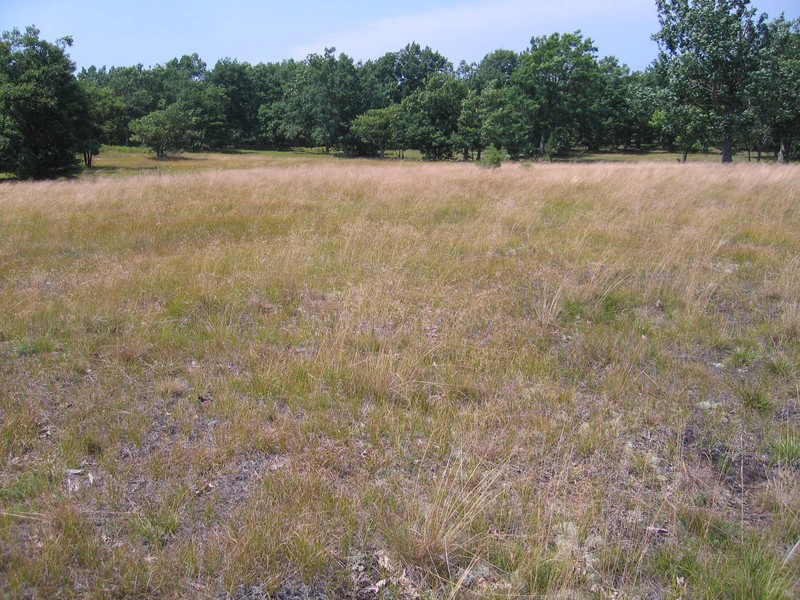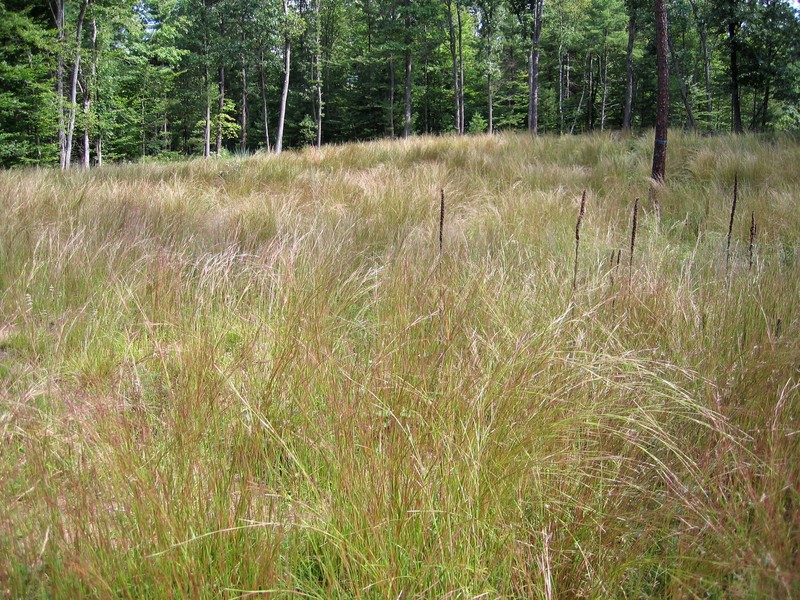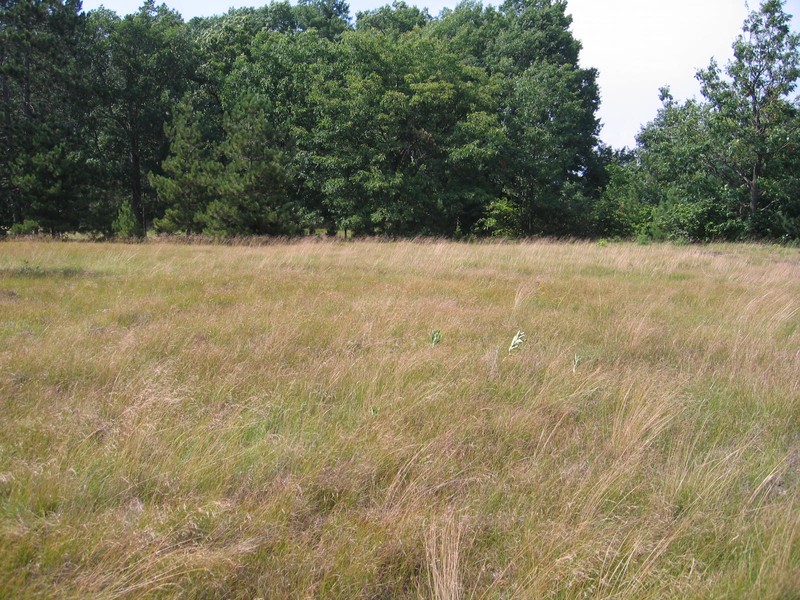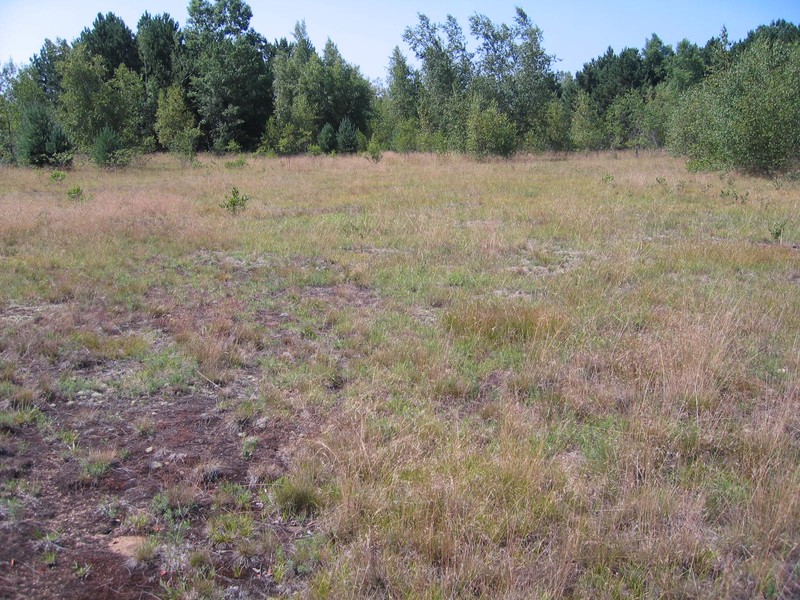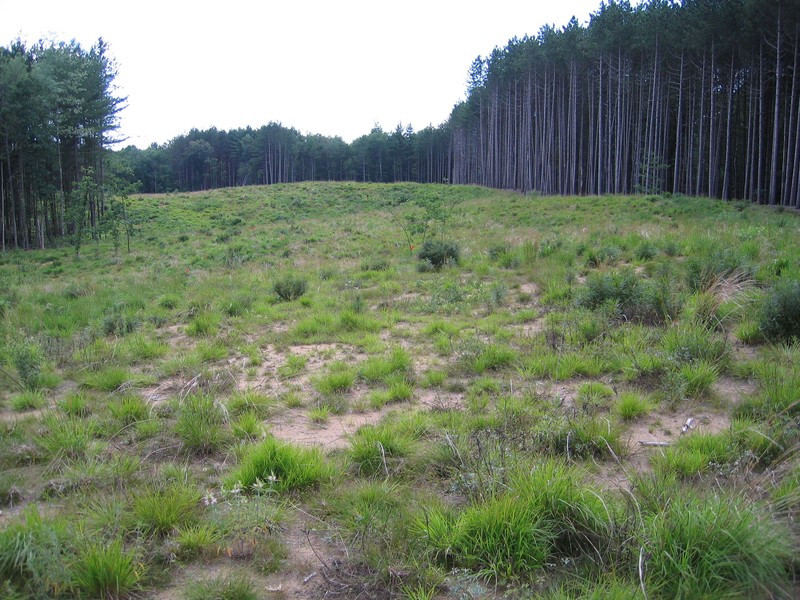Successional Northern Sandplain Grassland
- System
- Terrestrial
- Subsystem
- Open Uplands
- State Protection
- Not Listed
Not listed or protected by New York State.
- Federal Protection
- Not Listed
- State Conservation Status Rank
- S3
Vulnerable in New York - Vulnerable to disappearing from New York due to rarity or other factors (but not currently imperiled); typically 21 to 80 populations or locations in New York, few individuals, restricted range, few remaining acres (or miles of stream), and/or recent and widespread declines.
- Global Conservation Status Rank
- G4?
Apparently Secure globally (most likely) - Conservation status is uncertain, but most likely uncommon in the world but not rare; usually widespread, but may be rare in some parts of its range; possibly some cause for long-term concern due to declines or other factors. More information is needed to assign a firm conservation status.
Summary
Did you know?
The Karner blue butterfly (Lycaeides melissa samuelisis) is an endangered species and its caterpillars feed only on the leaves of wild lupine (Lupinus perennis ssp. perennis) which is sometimes found in successional northern sandplain grasslands in eastern New York (e.g., Albany Pine Bush and Wilton Wildlife Preserve and Park).
State Ranking Justification
This community is widespread throughout New York State, where the substrate is sand. There are an estimated 500 to 2,000 extant occurrences statewide and there are only a few good quality examples in New York. Successional northern sandplain grasslands are threatened by fire suppression, invasive species, and fragmenting development.
Short-term Trends
The number and acreage of successional northern sandplain grasslands in New York have probably declined slightly in recent decades due to fire suppression, disturbance by off-road vehicles, trash dumping, and development.
Long-term Trends
The number and acreage of successional northern sandplain grasslands in New York have probably had very large declines from historical numbers due to fire suppression, fragmentation, disturbance by off-road vehicles, trash dumping, and development.
Conservation and Management
Threats
As a fire-dependent natural community, the primary threat to successional northern sandplain grasslands is the suppression of fire. Lack of fire will likely result in the invasion of woody species from the surrounding woodlands that may convert the grasslands to shrublands and eventually to successional hardwoods. Other threats to this community include fragmenting development (e.g., residential, agricultural, commercial, roads, utility ROWs) and recreational overuse (e.g., ATV use, off-trail trampling, trash dumping). Nearly all examples of successional northern sandplain grasslands are threatened by invasive species: including invasive woody plants, such as black locust (Robinia pseudoacacia), shrubby honeysuckles (Lonicera tatarica, L. morrowii), and multiflora rose (Rosa multiflora), and garlic mustard (Alliara petiolata); and invasive herbaceous plants, such as spotted knapweed (Centaurea stoebe. ssp. micranthos), cypress spurge (Euphorbia cyparissias), and bird's-foot trefoil (Lotus corniculatus).
Conservation Strategies and Management Practices
Develop and implement prescribed burn plans at appropriate sites. Reduce or minimize fragmenting features, such as residential and commercial development, roads, abandoned clearings, unnecessary trails, etc. Restrict mountain bikes and ATVs to designated trails and least sensitive areas, and prevent dumping of trash. Remove or control invasive species where appropriate.
Development and Mitigation Considerations
This community is best protected as part of a pine barrens ecosystem, encompassing patches grasslands, scrub oak shrublands, and pitch pine-oak forests. Development should avoid fragmentation of such systems to allow for nutrient flow, seed dispersal, and seasonal animal migrations within them. Bisecting trails, roads, and developments can also allow exotic plant and animal species to invade.
Inventory Needs
Survey for occurrences statewide to advance documentation and classification of successional northern sandplain grassland. Continue searching for large sites in good condition (A- to AB-ranked).
Research Needs
Determine the optimal fire regime for this community.
Rare Species
- Aletris farinosa (White Colicroot) (guide)
- Asio flammeus (Short-eared Owl) (guide)
- Carex houghtoniana (Houghton's Sedge) (guide)
- Carex tincta (Tinged Sedge) (guide)
- Circus hudsonius (Northern Harrier) (guide)
- Hedeoma hispida (Rough Pennyroyal) (guide)
- Houstonia purpurea var. calycosa (Midwestern Purple Bluets) (guide)
- Houstonia purpurea var. purpurea (Large Purple Bluets) (guide)
- Lactuca hirsuta (Tall Hairy Lettuce) (guide)
- Lithospermum canescens (Hoary Puccoon) (guide)
- Piptatheropsis canadensis (Canada Rice Grass) (guide)
- Plebejus melissa samuelis (Karner Blue) (guide)
- Rumex hastatulus (Heart Sorrel) (guide)
- Scleria triglomerata (Whip Nut Sedge) (guide)
Range
New York State Distribution
This community is widespread throughout New York State, where the substrate is sand, but somehat restricted to sites where the substrate is moist sand and kept open through prescribed burning or infrequent mowing. It is probably represented by different regional variants. It is typically a small patch community with very few large patch occurrences known from the Great Lakes Plains.
Global Distribution
This broadly-defined community may be widespread at northern latitudes where the substrate is sand. Examples with the greatest biotic affinities to New York occurrences are suspected to span north to southern Canada, west to Minnesota, southwest to Indiana and Tennessee, southeast to Georgia, and northeast to Nova Scotia.
Best Places to See
- Brandon Burn (Franklin County)
- Wilton Wildlife Preserve and Park (Saratoga County)
- Fort Drum (Training Areas 4 and 5) (Jefferson County)
- Albany Pine Bush (Albany County)
Identification Comments
General Description
A meadow community that occurs on open sandplains that have been cleared and plowed (for farming or development), and then abandoned. This community is usually dominated by a low, dry turf of sedges and grasses less than 30 cm (12 inches) tall, and includes patches of open sand and patches of soil covered with mosses and lichens.
Characters Most Useful for Identification
These grasslands are dominated grasses and sedges, such as little bluestem (Schizachyrium scoparium), hairgrass (Avenella flexuosa), Pennsylvania sedge (Carex pensylvanica), common poverty grass (Danthonia spicata), panicgrasses (Dichanthelium acuminatum ssp. columbianum, D. linearifolium, D. depauperatum), and other sedges (Carex rugosperma, C. lucorum). Characteristic herbs with low percent cover include bracken fern (Pteridium aquilinum var. latiusculum), stiff leaf aster (Ionactis linariifolius), butterflyweed (Asclepias tuberosa), round-head bushclover (Lespedeza capitata), whorled loosestrife (Lysimachia quadrifolia), and pale bluets (Houstonia longifolia).
Elevation Range
Known examples of this community have been found at elevations between 250 feet and 1,740 feet.
Best Time to See
Late summer (August-September) is an excellent time of year to see little bluestem (Schizachyrium scoparium) blowing in the breeze.
Successional Northern Sandplain Grassland Images
Classification
International Vegetation Classification Associations
This New York natural community encompasses all or part of the concept of the following International Vegetation Classification (IVC) natural community associations. These are often described at finer resolution than New York's natural communities. The IVC is developed and maintained by NatureServe.
- Little Bluestem - (Broomsedge Bluestem) - Goldenrod species Ruderal Meadow (CEGL006333)
NatureServe Ecological Systems
This New York natural community falls into the following ecological system(s). Ecological systems are often described at a coarser resolution than New York's natural communities and tend to represent clusters of associations found in similar environments. The ecological systems project is developed and maintained by NatureServe.
- Northeastern Interior Pine Barrens (CES202.590)
Characteristic Species
-
Trees > 5m
- Betula populifolia (gray birch)
- Pinus rigida (pitch pine)
- Quercus alba (white oak)
- Quercus rubra (northern red oak)
- Quercus velutina (black oak)
-
Shrubs 2 - 5m
- Corylus americana (American hazelnut)
- Pinus rigida (pitch pine)
- Populus tremuloides (trembling aspen, quaking aspen)
- Prunus serotina var. serotina (wild black cherry)
- Quercus ilicifolia (scrub oak, bear oak)
- Robinia pseudoacacia (black locust)
- Rubus flagellaris (northern dewberry)
-
Shrubs < 2m
- Betula populifolia (gray birch)
- Ceanothus americanus (New Jersey-tea)
- Comptonia peregrina (sweet-fern)
- Lonicera tatarica (Tartarian honeysuckle)
- Pinus rigida (pitch pine)
- Pinus strobus (white pine)
- Populus deltoides ssp. deltoides (eastern cottonwood)
- Populus grandidentata (big-toothed aspen)
- Populus tremuloides (trembling aspen, quaking aspen)
- Prunus serotina var. serotina (wild black cherry)
- Quercus ilicifolia (scrub oak, bear oak)
- Quercus velutina (black oak)
- Rubus allegheniensis (common blackberry)
- Rubus flagellaris (northern dewberry)
- Spiraea alba var. latifolia (broad-leaved meadow-sweet)
-
Herbs
- Asclepias syriaca (common milkweed)
- Asclepias tuberosa (butterfly-weed)
- Avenella flexuosa (common hair grass)
- Carex lucorum (long-beaked carpet sedge)
- Carex pensylvanica (Pennsylvania sedge)
- Carex rugosperma (wrinkle-seeded sedge)
- Centaurea stoebe ssp. micranthos (spotted knapweed)
- Comandra umbellata ssp. umbellata (bastard-toadflax)
- Cyperus houghtonii (Houghton's flat sedge)
- Cyperus lupulinus ssp. macilentus (eastern flat sedge)
- Danthonia spicata (poverty grass)
- Dichanthelium clandestinum (deer-tongue rosette grass)
- Dichanthelium columbianum (District of Columbia rosette grass)
- Dichanthelium depauperatum (poverty rosette grass)
- Dichanthelium linearifolium (linear-leaved rosette grass)
- Dichanthelium xanthophysum (strict rosette grass)
- Euthamia graminifolia (common flat-topped-goldenrod)
- Fragaria virginiana ssp. virginiana (common wild strawberry)
- Hieracium sp.
- Houstonia longifolia (long-leaved bluets)
- Hypericum perforatum ssp. perforatum (common St. John's-wort)
- Ionactis linariifolia (stiff-leaved-aster)
- Lespedeza capitata (round-headed bush-clover)
- Lupinus perennis ssp. perennis (wild lupine, sundial lupine)
- Lysimachia quadrifolia (whorled-loosestrife)
- Monarda punctata var. punctata (dotted horse-mint)
- Panicum virgatum (switch grass)
- Poa pratensis ssp. pratensis (common Kentucky blue grass)
- Polygala polygama (bitter milkwort)
- Polygonum articulatum (northern jointweed)
- Potentilla simplex (old-field cinquefoil)
- Pteridium aquilinum ssp. latiusculum (eastern bracken fern)
- Rumex acetosella ssp. pyrenaicus (sheep-sorrel)
- Schizachyrium scoparium var. scoparium (little bluestem)
- Solidago canadensis var. canadensis (Canada goldenrod)
- Solidago juncea (early goldenrod)
- Sorghastrum nutans (Indian grass)
- Verbascum thapsus (common mullein)
-
Nonvascular plants
- Cladonia arbuscula ssp. mitis
- Cladonia cristatella
- Cladonia rangiferina
- Polytrichum juniperinum
- Polytrichum piliferum
Similar Ecological Communities
- Alvar pavement grassland
(guide)
Successional northern sandplain grasslands occur on sandy soil and are dominated by bluestem (Schizachyrium scoparium), hairgrass (Avenella flexuosa), Pennsylvania sedge (Carex pensylvanica), poverty grass (Danthonia spicata), and panic grasses (Dichanthelium spp.). Alvar pavement grasslands occur on Chaumont limestone (Galoo-Rock outcrop complex) and are dominated by small rush grass (Sporobolus neglectus), sheathed rush grass (S. vaginiflorus), Philadelphia panic grass (Panicum philadelphicum), Canada bluegrass (Poa compressa), upland white aster (Oligoneuron album), poverty grass (Danthonia spicata), false pennyroyal (Trichostema brachiatum), balsam ragwort (Packera paupercula), Crawe's sedge (Carex crawei), and wiry panic grass (Panicum flexile).
- Dry alvar grassland
(guide)
While these communities may share similar species, successional northern sandplain grasslands occur on sandy soil and are dominated by bluestem (Schizachyrium scoparium), hairgrass (Avenella flexuosa), Pennsylvania sedge (Carex pensylvanica), poverty grass (Danthonia spicata), and panic grasses (Dichanthelium spp.). Whereas, dry alvar grasslands occur on Chaumont limestone (Galoo-Rock outcrop complex) and are dominated by poverty grass (Danthonia spicata), Canada bluegrass (Poa compressa), and sometimes little bluestem (Schizachyrium scoparium).
- Floodplain grassland
(guide)
While these communities may share similar species, successional northern sandplain grasslands occur on sandy soil and are dominated by bluestem (Schizachyrium scoparium), hairgrass (Avenella flexuosa), Pennsylvania sedge (Carex pensylvanica), poverty grass (Danthonia spicata), and panic grasses (Dichanthelium spp.) Floodplain grasslands occur on relatively stable sand/gravel or cobble substrate and are dominated by big bluestem (Andropogon gerardii), Indian grass (Sorghastrum nutans), and switch grass (Panicum virgatum).
- Hempstead Plains grassland
(guide)
While these communities may share similar species, successional northern sandplain grasslands occur on sandy soil and are dominated by bluestem (Schizachyrium scoparium), hairgrass (Avenella flexuosa), Pennsylvania sedge (Carex pensylvanica), poverty grass (Danthonia spicata), and panic grasses (Dichanthelium spp.) Hempstead Plains grasslands are a tall grassland community that occurs on rolling outwash plains in west-central Long Island and are dominated by little bluestem (Schizachyrium scoparium), rush (Juncus greenei), and hyssop-leaved boneset (Eupatorium hyssopifolium).
- Maritime grassland
(guide)
While these communities may share similar species, successional northern sandplain grasslands occur on sandy soil and are dominated by bluestem (Schizachyrium scoparium), hairgrass (Avenella flexuosa), Pennsylvania sedge (Carex pensylvanica), poverty grass (Danthonia spicata), and panic grasses (Dichanthelium spp.). Maritime grasslands occur on rolling outwash plains of the glaciated portion of the coastal plain, near the ocean and within the influence of offshore winds and salt spray. They are dominated by little bluestem (Schizachyrium scoparium), common hairgrass (Avenella flexuosa), and poverty-grass (Danthonia spicata).
- Rocky summit grassland
(guide)
While these communities may share similar species, successional northern sandplain grasslands occur on sandy soil and are dominated by bluestem (Schizachyrium scoparium), hairgrass (Avenella flexuosa), Pennsylvania sedge (Carex pensylvanica), poverty grass (Danthonia spicata), and panic grasses (Dichanthelium spp.). Rocky summit grasslands occur on rocky summits and exposed rocky slopes of hills and are dominated by bluestem (Schizachyrium scoparium), tufted hairgrass (Avenella flexuosa), poverty-grass (Danthonia spicata, D. compressa), and Indian grass (Sorghastrum nutans).
- Successional old field
While these communities may share similar species, successional northern sandplain grasslands occur on sandy soil and are dominated by bluestem (Schizachyrium scoparium), hairgrass (Avenella flexuosa), Pennsylvania sedge (Carex pensylvanica), poverty grass (Danthonia spicata), and panic grasses (Dichanthelium spp.). Successional old fields are meadows dominated by forbs and grasses that occurs on sites that have been cleared and plowed (for farming or development), and then abandoned. They are dominated by goldenrods (Solidago spp.), and various pasture grasses, such as bluegrasses (Poa spp.), timothy (Phleum pratense), quackgrass (Elymus repens), smooth brome (Bromus inermis), sweet vernal grass (Anthoxanthum odoratum), orchard grass (Dactylis glomerata).
- Wet alvar grassland
(guide)
Successional northern sandplain grasslands occur on sandy soil and are dominated by bluestem (Schizachyrium scoparium), hairgrass (Avenella flexuosa), Pennsylvania sedge (Carex pensylvanica), poverty grass (Danthonia spicata), and panic grasses (Dichanthelium spp.). Whereas, wet alvar grasslands occur on Chaumont limestone (Galoo-Rock outcrop complex) and are dominated by tufted hairgrass (Deschampsia cespitosa), Crawe's sedge (Carex crawei), prairie dropseed (Sporobolus heterolepis), and flat-stemmed spikerush (Eleocharis elliptica var. elliptica).
Vegetation
Percent cover
This figure helps visualize the structure and "look" or "feel" of a typical Successional Northern Sandplain Grassland. Each bar represents the amount of "coverage" for all the species growing at that height. Because layers overlap (shrubs may grow under trees, for example), the shaded regions can add up to more than 100%.
Additional Resources
References
Albany Pine Bush Commission. 2017-2018. Successional northern sandplain grassland plot data (MS Excel files). Albany Pine Bush Commission, Albany, NY.
Edinger, G. J., D. J. Evans, S. Gebauer, T. G. Howard, D. M. Hunt, and A. M. Olivero (editors). 2014. Ecological Communities of New York State. Second Edition. A revised and expanded edition of Carol Reschke’s Ecological Communities of New York State. New York Natural Heritage Program, New York State Department of Environmental Conservation, Albany, NY. https://www.nynhp.org/ecological-communities/
Edinger, G.J., A.M. Chaloux, J.D. Corser, A.L. Feldmann, K.A. Perkins, R.M. Ring, M.D. Schlesinger, and E.L. White. 2013. Rare Species and Significant Natural Communities of Fort Drum Military Installation. New York Natural Heritage Program, Albany, NY.
Edinger, G.J., S.C. Brock, A.M. Chaloux, J.D. Corser, L. Lyons-Swift, M.D. Schlesinger, J.J. Schmid, F.C. Sechler, Jr., and E.L. White. 2011. Ecological and zoological inventory of the Saratoga Sandplains. New York Natural Heritage Program, Albany, NY.
Howard, T.G., A.K. Conley, and G.J. Edinger 2018. A new land cover classification for the Albany Pine Bush. New York Natural Heritage Program, Albany, NY.
Jenkins, Jerry. 1992. Brief summary of the findings of the 1992 botanical survey of Fort Drum. Unpublished report for the New York Natural Heritage Program, October 1992, 2nd draft. New York Natural Heritage Program, New York State Department of Environmental Conservation. Latham, NY. 21 pp. plus appendix, December 1992.
New York Natural Heritage Program. 2024. New York Natural Heritage Program Databases. Albany, NY.
Reschke, Carol. 1992. Significant communities surveyed at Fort Drum, summer 1992. Unpublished report. New York Natural Heritage Program, New York State Department of Environmental Conservation. Latham, NY. 3 pp.
Links
About This Guide
This guide was authored by: Gregory J. Edinger
Information for this guide was last updated on: November 15, 2023
Please cite this page as:
New York Natural Heritage Program. 2024.
Online Conservation Guide for
Successional northern sandplain grassland.
Available from: https://guides.nynhp.org/successional-northern-sandplain-grassland/.
Accessed July 26, 2024.
